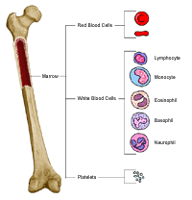Living with Aplastic Anemia
Aplastic anemia is a rare blood disorder. While it can occur at any age, it's most often diagnosed in children, teens, and young adults. It happens when bone marrow, the spongy tissue inside bones, doesn’t make enough red blood cells, white blood cells, and platelets. Red blood cells carry oxygen through the bloodstream to all areas of the body. White blood cells fight infections. Platelets help blood clot if bleeding starts.
 |
| Click Image to Enlarge |
Researchers don't know why some children have this bone marrow problem. Symptoms develop when blood cells aren’t replaced fast enough. Red blood cells live for about 120 days. Platelets live for about 7 to 10 days. White blood cells live for less than 1 day.
What are the symptoms and treatment of aplastic anemia?
If your child's red blood cell count gets too low, they may tire easily. Bleeding may occur if platelets are low. Infections may develop if white blood cells are low.
These are symptoms of aplastic anemia:
-
Bruising or bleeding
-
Fever
-
Weakness
-
Pale skin
-
Rapid heart rate
-
Shortness of breath
-
Skin rash
Treatment for aplastic anemia will depend on the age of the child and how severe the anemia is. Treatments often need to be repeated, and sometimes several types of treatment may be tried in order to find the one that works best.
Your child's treatment may be managed by a hematologist. This is a healthcare provider who specializes in blood disorders. Treatments may include:
Helping your child live with aplastic anemia
During and between treatments, it’s important to prevent complications of aplastic anemia caused by infections, bleeding, or extreme tiredness (fatigue). This is very important when blood cell counts are low.
Here are some basic tips to keep in mind:
-
Safe nutrition. It’s important for your child to eat a healthy diet. Your child may be at risk for foodborne illness. Because of this, they may need to not eat aged cheeses or drink unpasteurized milk or juices. Your child should not eat undercooked or raw foods. Make sure to cook all foods fully. Wash and peel fresh fruits and vegetables before serving. Don't let your child eat at salad bars or restaurant buffets. If you have dietary questions, ask the healthcare provider for a referral to a registered dietitian for additional support.
-
Safe exercise. Regular exercise and playtime are important, and so is resting between activities. If your child gets short of breath when active, let your healthcare provider know. Because your child may be at risk for bleeding, infection, and fatigue, contact sports are usually discouraged. If your child is school-age, work with teachers and coaches so your child can take part safely in peer activities.
-
Preventing infection. Make sure your child gets a flu shot every year and ask their healthcare provider about other preventive vaccines. Stay away from crowds and sick friends or relatives, especially during cold and flu season. Remind your child—and the rest of the family—to wash hands often. Regular dental care will help prevent tooth and gum infections. Keep your child out of public pools and hot tubs, especially if your child’s skin has any open cuts or scrapes. Don't let anyone smoke around your child. This includes in your home and car.
Learn as much as you can about aplastic anemia and work closely with your child's hematologist and treatment team. Also remember that a serious and recurrent illness like aplastic anemia is stressful for both you and your child. Make sure you both get the support you need. In an age-appropriate manner, include your child in the medical process. Educate them about aplastic anemia. Encourage them to write down questions about the condition and ask them during the medical appointments. If you or your child is struggling with anxiety or depression, talk with healthcare provider. Individual counseling, family counseling, or a support group can help.